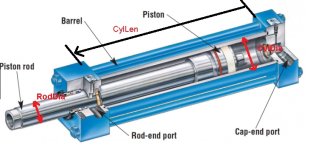Dear Sir,
is it possible to draw sketch of the system so I can visualize this cylinder that you're referring to in your calculation?
You don't want to design the system like we did. We designed our system to be difficult to control. You want to design your system to be easy control.
We make hydraulic servo controllers. You can get a design guide here
https://deltamotion.com/
P.S. I have seen the video. It is very impressive, but I'm not really sure about this double derivative gain. Does it means that you use P+I+D+D^2 control (you calculate derivative of differential component of your PID controller)?
Yes! The second derivative gain is necessary on systems with low natural frequency and low damping factor like the one in the video.
You could design a system with a higher natural frequency and more friction for a higher damping factor so it may be possible to control with a normal PID with velocity and acceleration feed forwards but that gets expensive. The mechanical damping wastes energy and increasing the natural frequency requires either reducing the mass of the load or increasing the diameter of the cylinder. Increasing the diameter of the cylinder is costly because it requires more flow and bigger components.
[quote
For someone who is not really familiar with this software, it is hard to understand.
[/quote]
It shouldn't be. There are a target and actual position, target and actual velocity. The green line is the control output.
Why green line (control output) is such noisy? I think actual actuator and mass cannot move the way green line is changing.
The 'noise' isn't really 'noise'. It is due the the resolution of the feed back. The 0.000001 meter resolution can only calculate an acceleration rate with a resolution of 1 m/s^2
Since the second derivative gain is multiplied by the error between the target and actual acceleration and the actual acceleration has a resolution of 1m/s^2 then the control output changes in small jumps. The second derivative gain is important and this is something that most controllers do not have.
On top of that we can use our model based control where we use a model to compute the actual velocity and acceleration with floating point resolution. The elminate's most of the 'noise' due to resolution.
Use 1 micron feedback. Mount the valve directly on the cylinder. Size the accumulator properly and mount it by the valve.
BTW, PLCs couldn't possibly do this.






